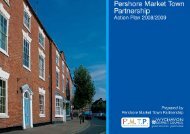Revised Deposit Plan - Wychavon District Council
Revised Deposit Plan - Wychavon District Council
Revised Deposit Plan - Wychavon District Council
Create successful ePaper yourself
Turn your PDF publications into a flip-book with our unique Google optimized e-Paper software.
4.2.62.The distinctive character of an individual Conservation Area is derived from a<br />
wide range of interrelated historical and architectural elements. These include<br />
the design and mixture of historic buildings, street patterns, building lines/scale<br />
and plot layouts, the relationship between buildings and spaces, the mix of<br />
uses of land and buildings as well as a variety of other features such as views,<br />
vistas, landmarks, open spaces, vegetation, hard landscaping and building<br />
materials, street furniture, building materials, night-time appearance and other<br />
elements. It is the combination of all of these qualities which contribute to the<br />
character and appearance of Conservation Areas. Their character, therefore,<br />
is not solely dependent on the quality of individual buildings.<br />
4.2.63.The <strong>Council</strong> intends to undertake Conservation Area Assessments and<br />
compile design guidance for Conservation Areas during the <strong>Plan</strong> period which<br />
will review and detail the elements which contribute to the special qualities and<br />
character of individual Conservation Areas, to assist the decision making<br />
process.<br />
4.2.64.Proposals for development will be assessed to ensure that a scheme will either<br />
preserve or enhance the character and appearance of an area. It is not the<br />
intention that new development or changes of use of land or buildings should,<br />
unduly, be prevented but, instead, that schemes respect the qualities of an<br />
area. It follows that development which would not respect the qualities of an<br />
area would result in the degradation of an area’s character and, therefore, will<br />
be resisted.<br />
4.2.59 Generally, however, there are a number of broad principles against which all<br />
proposals within Conservation Areas will be considered. To ensure that<br />
development harmonises with its surroundings, proposals will be expected to<br />
be sited or positioned in a way which does not undermine the historic context<br />
of a Conservation Area - its street patterns and plot layouts for example.<br />
Additionally, the design of new development should respect that of adjacent<br />
buildings in terms of proportions, scale, building lines and roof profiles. Abrupt<br />
changes should be avoided. These broad principles will apply to proposals for<br />
both modern and traditional designs within Conservation Areas.<br />
4.2.65. In this respect iIt is not the intention of the <strong>Council</strong> to stifle all efforts towards<br />
innovative design within Conservation Areas. Materials and elevational<br />
treatment will be an important aspect of modern designs and modern<br />
interpretations of traditional and locally distinctive materials and design<br />
elements will be considered.<br />
4.2.66. The majority of schemes within Conservation Areas will involve traditional<br />
design and in those cases, strong close attention to traditional detailing,<br />
materials, elevational proportions and traditional building technique will be<br />
equally as important as the broader design issues such as height, scale and<br />
position, if the special quality of a Conservation Area is not to be undermined.<br />
4.2.67. In addition, proposals should not result in the loss or destruction of any feature<br />
which makes a positive contribution to the character or appearance of a<br />
Conservation Area. Changes of use in Conservation Areas will be viewed<br />
cautiously but an application is likely to succeed if it would enhance the vitality<br />
of an area or provide for the re-use of an historic building. Proposals which<br />
would lead to traffic or environmental problems or which would be harmful to<br />
an area’s character will be resisted. Within Conservation Areas, controls exist<br />
over the demolition of unlisted buildings and structures and control over works<br />
to trees.<br />
<strong>Wychavon</strong> <strong>District</strong> Local <strong>Plan</strong> <strong>Revised</strong> <strong>Deposit</strong> (July 2003) Page 77<br />
097








